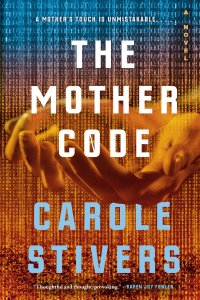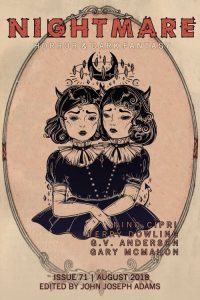Paul Di Filippo Reviews The Mother Code by Carole Stivers
 The Mother Code, Carole Stivers (Berkley 978-1984806925, 352pp, $26, hardcover) August 2020.
The Mother Code, Carole Stivers (Berkley 978-1984806925, 352pp, $26, hardcover) August 2020.
With her debut novel The Mother Code (as we shall learn, the title refers to AI software routines meant to emulate the maternal instinct), Carole Stivers joins the elite ranks of SF authors who have actual science creds, either academically or vocationally or both. Asimov, Benford, Clarke, Alastair Reynolds. The list can be extended, but it’s still relatively short, given the huge number of folks who have written SF. In the case of Stivers, her experience lies in the field of biochemistry, and her novel certainly benefits from her (speculative) expertise. But if factual accuracy of invention were all we got from The Mother Code, it would hardly be outstanding or worthy of our attention. (Or the attention of Hollywood, which has already optioned the tale.) Instead, Stivers counterbalances her scientific knowledge with excellent storytelling skills, very sturdy and engaging prose, and a raft of eternal themes that underlie the human condition.
The book is really an amalgam of several novels in one, all intertwined and supportive of each other, working in perfect synchronization.
The most obvious aspect of the book is a meditation on motherhood. In this regard, Stivers also finds herself in a smallish group, for science fiction has traditionally not often dealt with the topic. Bradbury, Judith Merril, Philip Jose Farmer, Frank Herbert—mothers have played important roles in their works, but their peers are not many.
Her book is also a very taut and effective future-plague novel. Exactly why so many SF books lately are proving to be predictive of the COVID pandemic remains to be explained! Certainly the Zeitgeist was quivering a year or two ago when these books were conceived and written!
And her book is also a fine post-collapse portrait.
Let’s see how all those pieces fit together.
The year is 2049, and we will meet our cast in some elegant plot setups that get the ball rolling. We will follow these people over the next fifteen years or so. There’s scientist James Said, expert in a certain kind of nanotech. There’s Colonel Rick Blevins, CIA analyst. Rudy Garza, a government biology researcher. Rose McBride, AI expert. Security Chief Kendra Jenkins. And a host of other less pivotal but thoroughly fleshed out contemporaries.
What gathers all these folks together is a horrifying scenario. An engineered biowarfare organism has been deliberately released on a battlefield. It was conceived to go dead upon first usage, and not replicate. But thanks to a very clever ecological niche mechanism, lucidly explained, the deadly agent can now replicate. It works by basically turning the victim’s lungs to dead meat (shades of COVID!). There seems to be no way to stop it, and so in due time the human race is doomed as the bug slowly spreads.
Our attention now jumps to the 2060s, and to a desert wasteland. There we meet children who have never had parents or contact with any other humans. They have been nurtured solely by artificial mothers, giant robots-cum-mechasuits who provide nourishment, education, and shelter. One of these children is named Kai. On a certain day, his Mother instructs him that they will begin looking for his peers. Soon he meets a girl named Sela, then another boy named Kamal. Their lives in the desert are intimately detailed, as is their wonderment about the world and their place in it, what lies beyond.
We will bop back and forth between these two eras, until they gradually converge. What we learn is that the children and the Mothers were a last-ditch effort to engineer humanity’s heirs, children with altered genomes not susceptible to the plague. The children and the surviving adults (palliative medicines and surgeries have preserved a handful of elite experts) will eventually converge on San Francisco’s Presidio, where a reunion between the two camps will be facilitated by Misha, one of the new generation raised by the adults, not by a machine.
As I said earlier, Stivers works all three of her aspects fluidly and deftly, weaving the threads into a captivating tapestry.
The relations between the children and the Mothers showcase the universality of caring and intimacy and protectiveness, whether organic or cybernetic. In this matter, Stivers joins Hugh Howey’s Half Way Home, which featured machine-raised kids on an alien planet.
The plague theme is devastatingly nasty, sad, and vivid. The stupidity of the origin, the inevitability of mankind’s demise, the bravery and heroism of the struggling scientists and others—it all comes across with force and color.
The post-collapse aspects, where we are shown the empty streets of San Francisco, etc., is haunting. But even more so, as in Will McIntosh’s Defenders, is the sense of a humanity branching off into an inheritor species, and how the baseline humans must deal with this obsolescence. The character of Misha, with one foot in each camp, is a very fine device for the reconciliation. We also encountered this motif in Cixin Liu’s Supernova Era. And amusingly, I also found the plight of the kids in the desert akin to Jack Kirby’s great Kamandi series. No hybrid tiger generals, but you can’t have everything!
Shifting effortlessly from the lab to the printed page, Carole Stivers illustrates that great science fiction must be equal parts test tube and beating maternal heart.
 While you are here, please take a moment to support Locus with a one-time or recurring donation. We rely on reader donations to keep the magazine and site going, and would like to keep the site paywall free, but WE NEED YOUR FINANCIAL SUPPORT to continue quality coverage of the science fiction and fantasy field.
While you are here, please take a moment to support Locus with a one-time or recurring donation. We rely on reader donations to keep the magazine and site going, and would like to keep the site paywall free, but WE NEED YOUR FINANCIAL SUPPORT to continue quality coverage of the science fiction and fantasy field.
©Locus Magazine. Copyrighted material may not be republished without permission of LSFF.






